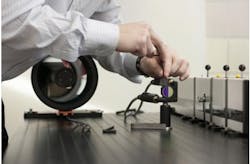Spectroscopy detects explosives over long distances
Researchers at the Vienna University of Technology (Vienna, Austria) have developed a system to detect chemicals inside a container over a distance of more than a hundred meters.
The system is based on the use of Raman spectroscopy, in which a sample is illuminated by a laser and the shift in wavelength of the inelastically scattered radiation from it is measured to provide information on its chemical and structural properties.
"Until now, the sample had to be placed very close to the laser and the light detector for this kind of Raman spectroscopy," says Professor Bernhard Lendl from the Vienna University of Technology.
But the new system works over long distances -- even if the sample is hidden in a nontransparent container. Although the majority of the light from the laser beam is scattered by the container wall, a small portion of the beam penetrates the sample in the container where it can still excite the Raman-scattering processes.
According to Lendl, the challenge that the researchers faced was to distinguish the signal reflected from the container from that reflected by the sample.
This was achieved by aiming a telescopic detector at a region just a few centimeters away from where the laser hits the container -- a region where the light which enters the container would be scattered.
In the project -- which was funded by the EU -- the researchers collaborated with private companies and with partners in public safety, including The Spanish Guardia Civil.
During the project, the Austrian military was also involved. On their testing grounds the researchers from TU Vienna tested frequently-used explosives, such as TNT (trinitrotoluene), ANFO (ammonium nitrate/fuel oil) or RDX (Research Department eXplosive). The tests were highly successful; even at a distance of more than a hundred meters, the substances could be detected reliably.
-- by Dave Wilson, Senior Editor, Vision Systems Design
